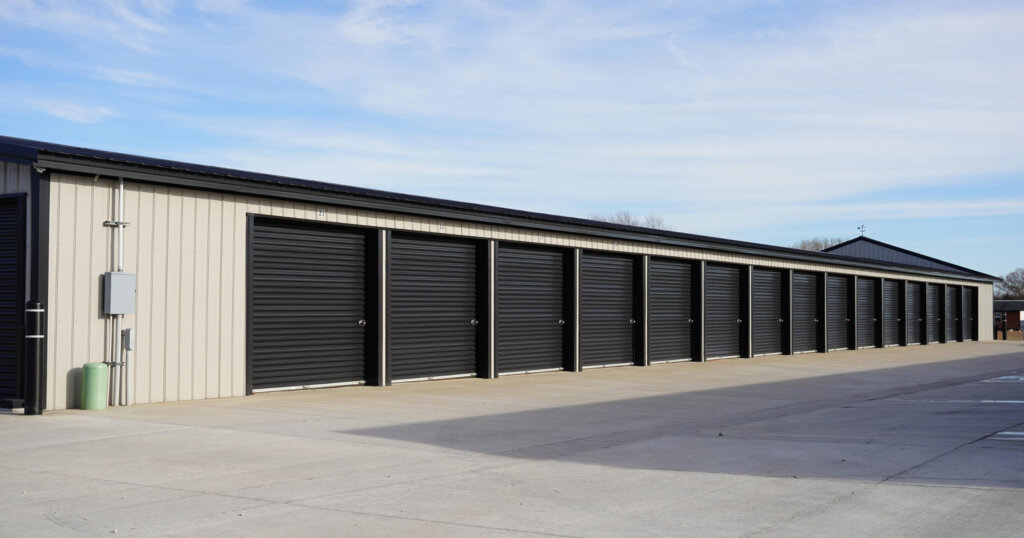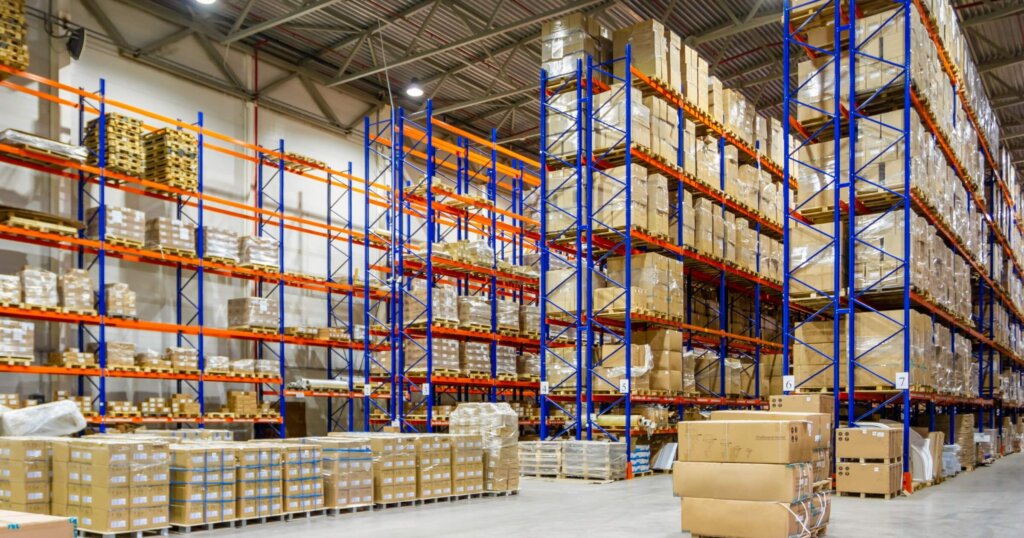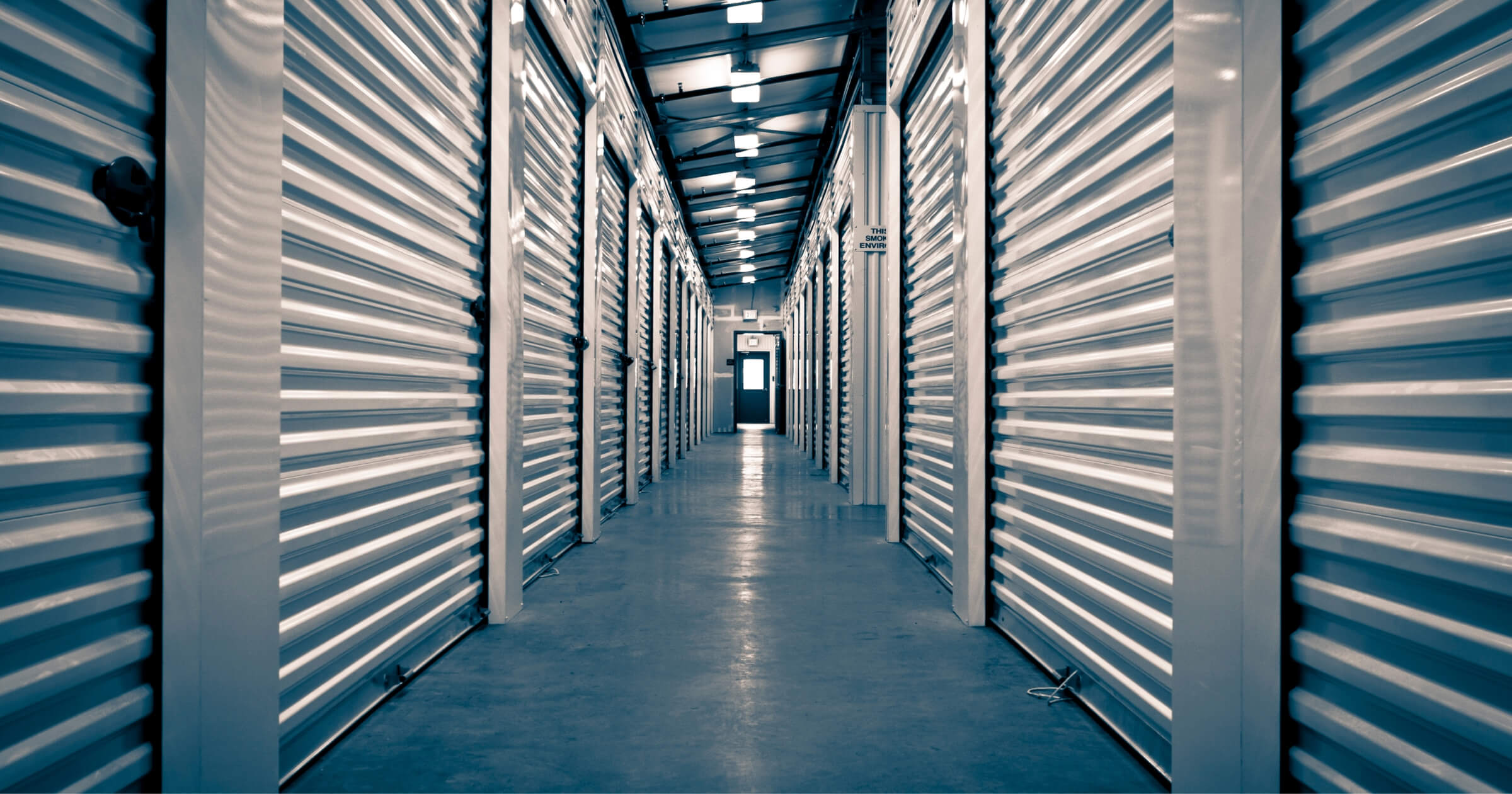Whether you’re a contractor, a small business owner, or a real estate investor, building a storage facility can be a great investment. In this guide, we’re going to cover how much it costs to build a storage facility per square foot, what factors affect building costs, and the different ways to build one.
Quick look:
- Expect to spend between $25–$75 per square foot in the U.S., or up to $3M+ for large, custom facilities with advanced features like climate control and multi-story layouts.
- Key factors influencing price include facility size, choice of steel, wood, or concrete materials, and design complexity such as indoor access or HVAC systems.
- Urban builds cost more due to land and labor rates, while rural builds can be cheaper but may face material delivery or labor availability challenges.
- For many businesses, self-storage ownership reduces rental costs and provides flexibility, especially when aligned with growth goals and location needs.
Average cost to build a storage facility
The average cost to build a storage facility typically falls between $25 and $75 per square foot in the U.S. or $35 to $100 in Canada. That range can shift depending on regional labor costs, the type of storage units being built, and whether the facility includes advanced features like climate-controlled units or multi-story layouts.
- A small, single-story facility with around 50 basic units usually costs between $350,000 and $550,000 USD, depending on land purchase price, construction materials, and site development costs.
- A mid-size facility with roughly 100 standard units might run between $700,000 and $1.5 million USD, especially if it includes a mix of vehicle storage, container storage, and office equipment areas.
- A large or custom facility, particularly one with multiple floors, high-end security systems, or indoor climate-controlled storage space, can easily exceed $2 million USD.

Photo courtesy of shutterstock.
Land costs, market demand, and occupancy rates also play a significant role in the total storage facility construction cost. Facilities in high-demand urban areas typically see higher land and labor costs but can charge premium rental rates to offset the initial investment. In contrast, building storage units in rural areas might come with lower startup costs, though lower population density could mean slower returns.
| Facility Size | Low Estimate (USD) | Mid Estimate (USD) | High Estimate (USD) |
| 50 units | $350,000 | $450,000 | $550,000 |
| 100 units | $700,000 | $1,000,000 | $1,500,000 |
| 150+ units | $1.5M | $2M+ | $3M+ |
Key factors affecting the cost of a storage facility
Size
One of the most important factors in determining the overall cost of building a storage facility is its size. Larger facilities require more square footage, which means more construction materials, higher labor costs, and a greater investment in land acquisition and site preparation. Whether you’re building 50 or 150 storage units, the size of the facility directly impacts your construction budget and long-term operational costs.
In general, a bigger build means:
- Higher material costs for structural framing, roofing, and insulation
- More labor hours for construction crews, electricians, and HVAC installers
- Increased land requirements and potentially higher land costs in urban areas
- Larger investment in security systems, access control, and customer service features like office space and digital kiosks
While the upfront cost of building more units can be significant, larger facilities often benefit from economies of scale. A higher unit count can lead to better occupancy rates, stronger annual revenue, and a healthier long-term profit margin, especially in regions with a high-demand self-storage market.
Materials
The type of construction materials used in a self-storage facility has a big impact on the cost, durability, and long-term maintenance. Material costs can vary widely based on your region, availability, and the level of protection or features you want to offer your customers.
Here are the most common materials used in self-storage construction:
- Metal (steel): The most popular choice in the self-storage industry, steel buildings are relatively quick to assemble, cost-effective, and highly durable. They’re also scalable, making them ideal for both small businesses and large-scale projects. However, they can trap heat in warmer climates if not properly insulated, which adds to climate control costs.
- Wood frame: While more affordable upfront, wood-framed buildings are rare in commercial self-storage development. They’re more vulnerable to weather damage, pests, and rot, which can lead to higher operational costs over time. Better suited for short-term or temporary structures.
- Concrete block or tilt-up: These premium options offer superior durability, fire resistance, and security, especially for high-end or multi-story self-storage buildings. While the initial investment is much higher, concrete delivers long-term value in high-traffic or urban areas where security and longevity are key.
Pros and cons of each material:
| Material | Pros | Cons |
| Steel | Durable, scalable | Can get hot without insulation |
| Wood | Cheap upfront | Prone to rot and pests |
| Concrete | Fireproof, secure | Expensive and labor-intensive to build |
Choosing the right material comes down to your construction budget, climate, and whether you’re prioritizing speed, durability, or long-term sustainability.
Complexity
The more complex the design, the higher the storage facility construction cost. A basic, single-story self-storage building with standard units and drive-up access is going to be much more affordable than a custom, multi-story facility with climate-controlled units, elevators, and interior access.
Here’s how design complexity can affect your total cost:
- Single-story vs. Multi-story: Single-story facilities are easier and cheaper to build, especially in rural areas with more available land. Multi-story self-storage buildings are common in dense urban areas where land costs are higher and vertical space is the more efficient option, but they come with added costs for elevators, structural reinforcement, and additional permits.
- Climate-controlled units: Adding HVAC systems to manage temperature and humidity can significantly increase your construction and operational costs. These types of units are popular in markets with extreme weather or high-value tenants storing electronics, furniture, or documents.
- Drive-up vs. Interior access: Drive-up units are convenient for customers and easier to build, while interior-access units typically require enclosed hallways, access control systems, and more enhanced security features. Interior designs are often preferred for multi-story facilities and in urban areas where safety and space are priorities.
Ultimately, the complexity of your facility should align with your target market, customer needs, and expected occupancy rates. More customized builds may have a higher initial investment, but they often command higher rental rates and long-term ROI in competitive self-storage markets.
Labor
Labor plays a significant role in the overall cost of building a storage facility, and how you approach it can make a big difference in your construction budget. Some business owners opt for DIY solutions, while others go the full-service contractor route depending on the size of the project and the level of expertise required.
- DIY builds: Pre-engineered self-storage building kits are available for smaller projects and typically range from $25 to $40 per square foot. These kits are a smart option for rural areas or businesses with access to their own construction crew. However, they require careful planning and understanding of local building codes.
- Contractor-built facilities: Hiring a professional builder often raises the price to $50 to $75+ per square foot, but that comes with the benefit of full-service support. Most contractors will handle everything from site preparation and permitting to zoning approvals, architectural details, and utility hookups. This is especially important for larger or more complex storage facility construction projects, such as multi-story self-storage or climate-controlled units.
While DIY builds can save money upfront, they also come with higher risks and potential delays. For most business owners investing in a new self-storage facility, especially in high-demand or regulated areas, contractor-built options offer greater peace of mind.
Location
Where you build your storage facility has a major impact on both upfront and long-term costs. From land acquisition to labor availability, regional differences can shape everything from your construction timeline to your profit margin.
- Urban areas: Building in or near cities typically comes with higher land costs, labor rates, and permit fees. While these locations often have better access to materials and contractors, they also involve more complex zoning requirements and may require additional security measures. On the upside, urban areas usually bring in more potential customers, higher occupancy rates, and the ability to charge premium rental rates.
- Rural or remote areas: Land is generally more affordable, and zoning tends to be less restrictive. However, delivery times for materials can be longer, and skilled labor may be harder to come by, leading to potential delays or higher labor costs if crews must travel in. Demand for self-storage may also be lower, depending on local population density and market research.
The location also affects property taxes, site preparation, and the overall cost of construction. For example, storage buildings in colder regions may require additional insulation or snow load considerations, while storage facilities in warmer climates might prioritize ventilation and shade structures. Choosing the right location is one of the most important factors in determining the success and long-term revenue potential of any self-storage development.
Permits
Permits and approvals are an important yet often overlooked part of the self-storage construction process. Depending on where you’re building, permit fees can range anywhere from $500 to over $25,000, and that doesn’t include the time or paperwork required to get them.
Every region has its own permitting process, but you’ll likely need approvals for:
- Zoning clearance – to confirm the land can legally be used for a self-storage facility
- Building permits – covering structural, electrical, and plumbing work
- Fire inspections – especially for multi-story facilities or those with indoor access
- Utility connections – including water, electricity, and sewer access
- Environmental reviews – in areas with sensitive land or development restrictions
In urban areas, where regulations are typically more complex, you may face higher permit costs and longer approval timelines. In rural areas, the process may be simpler, but it still requires due diligence.
Permitting is one of the “soft costs” in your total cost of building a storage facility, and it can influence your construction timeline, design limitations, and site improvement costs. It’s a good idea to factor these fees into your construction budget early, especially if you’re building a new self-storage facility from the ground up.
Is a storage facility a good investment for a business?

Photo courtesy of shutterstock.
For many small businesses, especially those in construction, landscaping, HVAC, plumbing, or seasonal services, building a self-storage facility can be a smart long-term investment. Instead of paying monthly rental rates for off-site storage, owning your own facility gives you full control over access, security, and layout. It also provides the flexibility to store tools, vehicles, office equipment, and excess inventory without relying on third-party providers.
A self-storage facility can also help centralize resources and make it easier to manage equipment between job sites. For businesses with recurring storage needs, the cost of building storage units often pays off faster than leasing comparable space.
Things to consider before building a storage facility:
- Location: Is it close to your job sites or customers? The right location can save time and reduce transportation costs.
- Cost vs. lease: Run the numbers; how long would it take for ownership to offset the cost of renting a similar facility?
- Security: Will you need access control, fencing, lighting, or surveillance cameras to protect valuable equipment?
- Growth potential: Is there room to expand? Planning for future square footage now can help avoid expensive rebuilds later.
Bottom line
Building a self-storage facility is a major investment that comes with benefits like reducing expenses and improving your operations. Costs can range from a few hundred thousand dollars to several million, depending on the size of the facility, location, labor, materials, and the level of complexity involved. Curious how storage facility construction stacks up against other large-scale builds?
- Check out the cost of building a dam
- Compare it to highway construction costs in 2025
- Or explore the future with 3D-printed house construction costs
If you want to learn more about building and construction, subscribe to our Under the Hard Hat newsletter to get real-world building tips delivered straight to your inbox.


